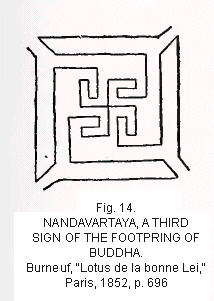

The Swastika
Definitions, Description & Origin
 Burnouf
says the above sign has many significations. It is a sacred temple of
edifice, a species of labyrinth, a garden of diamonds, a chain, a golden
waist or shoulder belt, and a conique with spires turning to the right.
Burnouf
says the above sign has many significations. It is a sacred temple of
edifice, a species of labyrinth, a garden of diamonds, a chain, a golden
waist or shoulder belt, and a conique with spires turning to the right.Colonel Sykes (2) concludes that, according to the Chinese authorities Fa-hian, Soung Young, Hiuan thsang, the "Doctors of reason, 'Tao-sse,or followers of the mystic cross (swastika) were diffused in China and India before the advent of Sakya in the sixth century B.C. (according to Chinese, Japanese, and Buddhist authorities, the eleventh century B.C.), continuing until Fa-hian's time; and that they were professors of a qualified Buddhism, which, it is stated, was the universal religion of Tibet before Sakya's advent. (3) and continued until the introduction of orthodox Buddhins in the ninth century A.D. (4)
Klaproth (5) calls attention to the frequent mention by Fa-hian, of the Tao-see, sectaries of the mystic cross (swastika) and to their existence in Central Asia and India; while he says they were diffused over the countries to the west and southwest of China, and came annually from all kingdoms and countries to adore Kassapo, Buddha's predecessor. (6) Mr. James Burgess (7) mentions the Tirthankaras or Jainas as being sectariaus of the Mystic Cross, the Swastika. The Cyclopaedia of India (title Swastika), coinciding with Prof. Max Müller says:
The Swastika symbol is not to be confounded with the Swastika sect in Tibet which took the symbol for its name as typical of the belief of its members. They render the Sanskrit Swastika as composed of sn "well" and asti "it is" meaning, as Professor Wilson expresses it, "so be it," and implying complete resignation under all circumstances. They claimed the Swastika of Sanskrit as the suti of Pali, and that the Swastika cross was a combination of the two symbols sutti-suti. They are rationalists, holding that contentment and peace of mind should be the only objects of life. The next has preserved its existence in different localities and under different names, Thirthankara, Ter, Musteg, Pon, the last name meaning purity, under which a remnant are still in the furthest parts of the most eastern province of Tibet.
ENDNOTES:
1. "Lotus de al Bonne Loi," p.626. [Back]
2. "Notes on the Religions, Moral, and Political state of India," Journ, Asaiatic soc. Great Britain, vi,pp.310-334. [Back]
3. Low, Trans. Roy. Asiatic Soc. of Great Britain iii,pp. 334,310. [Back]
4. Ibid.' p. 299. [Back]
5. Ibid.' p. 299. [Back]
6. Low, Trans. Roy. Asiatic Soc. of Great Britain iii, p.310. [Back]
7. Indian Antiquary, ii, May, 1873, p. 135. [Back]
<< Previous Page Next Page >>
© 2004-2007 Northvegr.
Most of the material on this site is in the public domain. However, many people have worked very hard to bring these texts to you so if you do use the work, we would appreciate it if you could give credit to both the Northvegr site and to the individuals who worked to bring you these texts. A small number of texts are copyrighted and cannot be used without the author's permission. Any text that is copyrighted will have a clear notation of such on the main index page for that text. Inquiries can be sent to info@northvegr.org. Northvegr™ and the Northvegr symbol are trademarks and service marks of the Northvegr Foundation.

|